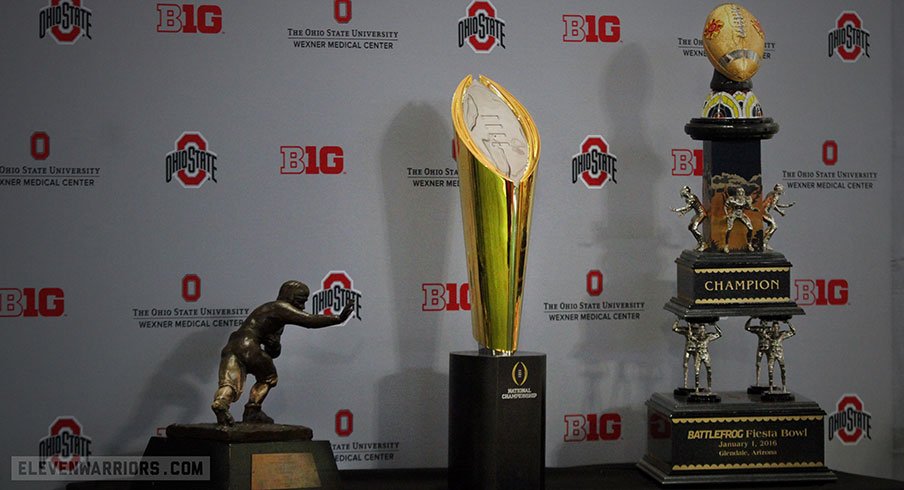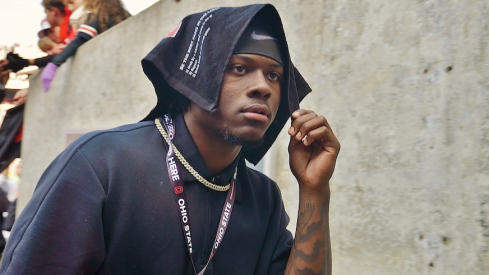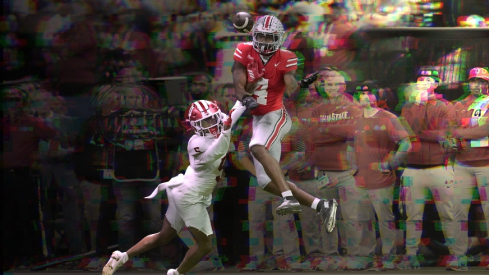When former Ohio State coach Jim Tressel took the helm in Columbus, it had been 33 years–since 1968–since a Buckeye head coach hoisted a national championship trophy.
Tressel, with a talented roster full of College Football Hall Of Fame coach John Cooper's players–and a necessary influx of his own–shocked the sports world less than two years later when he led Ohio State to a championship. The Buckeyes knocked off a Miami Hurricane team some consider the greatest collection of college talent ever, 31-24 in double overtime at the Fiesta Bowl.
Ten years and 10 months after Ohio State was named Tressel its head coach, Urban Meyer, after a year-long coaching hiatus, commandeered the Good Ship Fickell and helped right a floundering vessel that had been rocked by scandal and a 2011 football season that will likely go down as the worst you'll ever see by an Ohio State football team…in your life.
That's how good the life of a Buckeye fan has been in the last 100 years, and it's not an accident. It stems from tradition, a commitment to winning and, in today's college football landscape, a relentless pursuit of the best players in the country on the recruiting trail.
Tressel took over a football program that was full of talent, but was lacking leadership and culture. Meyer took over a program that many said would "never recover" from a (temporarily) NCAA-mandated demise that needed a coach with a chip on his shoulder and an ability to convince the holdovers from 2010 that 2012 and beyond it would be business as usual for the Scarlet and Gray. Both coaches were successful. Each of them won titles quickly, despite doing it in different ways on the field and in decidedly different eras of college football. Each of them proved that Ohio State's brand was strong and, though recruiting with different priorities, landed big-time talent from all over the country. Tressel's first five years on the recruiting trail led to one of the most successful decades in the history of Buckeye football and Meyer's first five have started in record fashion.
Let's examine the first five years of Tressel and Meyer, to see how one of the country's premier college football programs has been built and maintained.
All statistical recruiting information comes from Rivals.com for the purpose of this story.
| year | signees | national rank | star avg | % from ohio | five-stars | 4-yr win total |
|---|---|---|---|---|---|---|
| 2002 | 25 | 5 | 3.65 | 72% | 3 | 43 |
| 2012 | 25 | 4 | 3.72 | 64% | 2 | 50 |
In their first full recruiting class, both Tressel and Meyer racked up top five classes and signed a full allotment of 25, focusing on their talent-rich home state.
Tressel's first full class was highlighted by five-star tailback Maurice Clarett, who committed to the Buckeyes sight unseen when the Youngstown hero took the job in Columbus, and Avon Lake linebacker Mike D'Andrea. The group had a number of players go on to NFL careers including four first-round picks.
For Urban Meyer, 2012 was a whirlwind that began even before he was officially announced as the head coach in Columbus. His pending hire was cited by Adolphus Washington as a primary reason the Cincinnati star picked the Buckeyes in late November and it was Washington, along with fellow five-star defensive lineman Noah Spence, that really highlighted his first effort. A remarkable 50 wins and national championship later, Meyer's first class at Ohio State will leave a lasting legacy.
| year | SIGNEES | national rank | star avg | % from ohio | FIVE-STarS | 4-yr win total |
|---|---|---|---|---|---|---|
| 2003 | 16 | 41 | 3.38 | 81% | 0 | 41 |
| 2013 | 24 | 2 | 3.83 | 46% | 2 | N/A |
In 2003, Ohio State returned most of their 2002 national championship team, and because of that, a smaller-than-usual group of signees meant a substandard national ranking for Jim Tressel's group. Thirteen of the 16 players in 2003 were from Ohio, including future NFL draft picks Anthony Gonzalez and Donte Whitner, while the Buckeyes went to Texas to pluck four-star cornerback Ashton Youboty. Between limited number and even more limited production, this class is one that Tressel might've liked to do over again.
Meyer's second class was, without a doubt, the bedrock of Ohio State's 2015 College Football Playoff title run. Joey Bosa, Ezekiel Elliott, Darron Lee, Vonn Bell, Eli Apple, J.T. Barrett, Tyquan Lewis, Gareon Conley and more –– it may be the most talented recruiting class in Ohio State history.
| year | SIGNEES | national rank | star avg | % from ohio | five-stars | 4-yr win total |
|---|---|---|---|---|---|---|
| 2004 | 27 | 16 | 3.24 | 59% | 1 | 41 |
| 2014 | 23 | 3 | 3.74 | 39% | 1 | N/A |
If you consider that Ohio State played in a national championship game in 2007 (and 2008) you'd think that they must've put together a handful of great classes in a row early in Tressel's tenure, but the numbers don't really bear that. Though the 2004 class is much larger than the 2003 group, its productivity can only be described as lackluster. Two first-round picks (Ted Ginn Jr. and Vernon Gholston) emerged from the pack and quarterback Todd Boeckman, who was a "grayshirt" that season would help guide the Scarlet and Gray to the 2008 title game, but was never much more than a placeholder in the Buckeyes' offense.
The appropriately dubbed "Dream '14" for Meyer checked in as the country's third-ranked class, establishing–with three straight top five classes at Ohio State–the Buckeyes would continue to dominate the Big Ten. This group, now true juniors and redshirt freshmen in Columbus, is led by Raekwon McMillan, Sam Hubbard and Curtis Samuel though the 2016 season will be huge for this group's lasting legacy as guys like Demetrius Knox, Dante Booker, Erick Smith, Noah Brown and others look to emerge as go-to guys on the roster.
| year | SIGNEES | national rank | star avg | % from ohio | five-stars | 4-yr win total |
|---|---|---|---|---|---|---|
| 2005 | 18 | 12 | 3.50 | 61% | 1 | 43 |
| 2015 | 27 | 9 | 3.48 | 44% | 0 | N/A |
Highlighted by five-star offensive lineman Alex Boone, the 2005 recruiting class for Ohio State–like 2003–was small, but this one provided much more bang for the proverbial buck. Boone, Malcolm Jenkins, James Laurinaitis, Donald Washington, Brian Hartline, Brian Robiskie and Doug Worthington all found their way into the NFL and this group was a major part in back-to-back national title game appearances and played significant roles in re-establishing Ohio State as a year-in, year-out national power.
For Meyer and his 2015 group, which had 27 players in the class on signing day, but Jamel Dean and offensive lineman Mirko Jurkovic Jr. ending up elsewhere before the start of last season, things didn't work out quite as planned. As the immensely talented 2013 unit became national stars, this particular group faded into relative obscurity. Only four of these freshmen (Denzel Ward, Eric Glover-Williams, Isaiah Prince and Jerome Baker) saw the field and each of them did so in special teams roles almost exclusively. As the 2016 season begins, look for players like Justin Hilliard, Branden Bowen, Matt Burrell, Torrance Gibson and others to try and make their mark with the hopes of being the headliners in what could be the Buckeyes' next championship run in 2017.
| year | SIGNEES | national rank | star avg | % from ohio | five-stars | 4-yr win total |
|---|---|---|---|---|---|---|
| 2006 | 20 | 12 | 3.60 | 50% | 2 | 44 |
| 2016 | 25 | 3 | 3.79 | 36% | 2 | N/A |
Tressel's most successful recruiting class from his first five, the 2006 haul was a solid group that blended Ohio's best with a heavier-than-normal dose of national prospects, including three players from California, a rarity for Tressel's classes. Led by five-star tailback Beanie Wells, who was an NFL first-rounder, this class won 44 games as a group and also produced professional talent with Jake Ballard, Chimdi Chekwa, Kurt Coleman, Thaddeus Gibson, and Larry Grant.
The latest top five group signed by Meyer, the 2016 recruiting class will come to Ohio State this summer with big expectations. Some of them, like wide receiver Austin Mack, offensive lineman Michael Jordan and defensive lineman Jonathon Cooper, have already been singled out by the Buckeyes' coaching staff this spring as likely to contribute, signaling that unlike the 2015 group, there's a priority to get these youngsters on the field as soon as possible. Nick Bosa, Jordan Fuller, Demario McCall, Keandre Jones and more will fight for early playing time as they look to live up to the standard set by Meyer's previous groups.
In the 10 years that Jim Tressel was the head coach at The Ohio State University, the Buckeyes won 106 games and lost 22, winning the Big Ten seven times and playing in eight BCS bowl games. A time of unprecedented success, which is saying something consider the program's rich history, Tressel's first five years on the recruiting trail weren't his best years (the 2008 and 2009 classes each finished in the top five nationally). They did, however, provide the blueprint for a how to win at Ohio State in the ever-changing landscape of college football. Lock down Ohio, find the best players from Georgia, Florida, Pennsylvania and other football-rich areas that are willing to blaze their own trail and watch them flourish in an environment that produces good football players with an eye towards life after their playing days are gone.
Since taking over in November of 2011, Meyer and the Buckeyes have picked up the mantle and run with it, somehow moving the already dizzying heights of the football program to even higher ones.
An undefeated season is in his debut year, followed by 12 straight wins to start his second, culminating in three straight of the most impressive wins in Ohio State history to win the national championship in January of 2015, things don't appear to be slowing down in Columbus. Meyer's teams have won a remarkable 50 games against only four defeats and the incredible collection of talent he's assembled in his first five recruiting classes should keep the program moving in a positive direction well beyond his own time at Ohio State.


